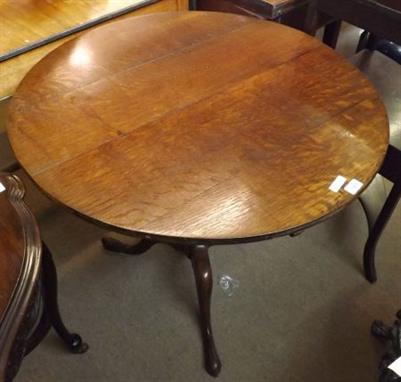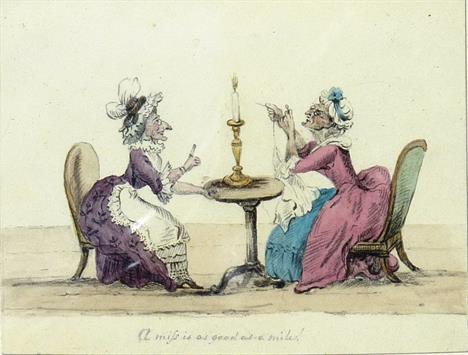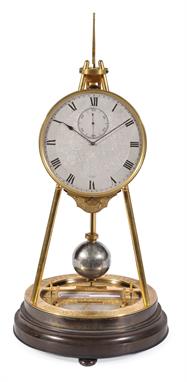We found 96096 price guide item(s) matching your search
There are 96096 lots that match your search criteria. Subscribe now to get instant access to the full price guide service.
Click here to subscribe- List
- Grid
-
96096 item(s)/page
A THORNTON PICKARD "IMPERIAL" PLATE CAMERA, c.1900, with brass mounted folding mahogany frame, Thornton-Pickard shutter, Stigmatic Series II lens No.62148 by J H Dallmeyer, four 6" x 8" mahogany plate holders, canvas carrying case and oak and brass mounted folding tripod by Thornton-Pickard, in case
A VICTORIAN WALNUT AND MARQUETRY WORK TABLE of circular tapering form, the quarter veneered lid depicting St George and the Dragon within a scrolling foliate border opening to reveal a fitted interior with well, waved frieze with turned pendants, baluster turned stem, on leaf carved tripod base with scrolled feet, 17 3/4" x 29"
A Chinese gilt bronze tripod censor with two plain loop handles, 6 character mark to base, 19th century, approx 17 cm dia Condition Report Verdigris to feet and patches to one side - tarnished overall commensurate with age. 1400 g in weight, 12cm inner diam, 17 cm outer diam Further images available on www.the-saleroom.com
A Chinese bronze tripod incense censer with integral loop handles, 19th century, six character mark to base, 16.5 cm diameter, height 9.5 cm Condition Report 1300 g in weight, to left hand side of one loop handle there is a short/small surface crack but it does not extend deeply, possibly a flaw in manufacture as opposed to a crack, 13 cm inner diam, 16.5 cm outer diam
An oak centre table, circa 1910 of Aesthetic design, with a carved frieze to the top and splayed feet, 54 by 54 by 75cm high, a Georgian tripod single pedestal oak table, with top detached, 60 by 70cm high, a Chinese white cloth covered cabin trunk with a P&O label, a dark blue leather bound cabin trunk with railway labels, 74 by 50 by 34cm high, and a small brown pigskin suitcase by Perry and Perry Dulce Street, Piccadilly, 50 by 34 by 17cm, an Edwardian mahogany single pedestal wine table on tripod base, a/f damaged, a side table with barley twist supports, a Victorian mahogany folding tilt top table, bobbin turned legs, with a circular top, a/f damaged, 69 by 84 by 72cm, and a pair of Georgian, Hepplewhite, elm dining chairs, with pierced splat and straight stretchers with dark brown velvet upholstery, 52 by 45 by 93cm high. (9) Provenance: The Estate of David Powell MBE.
A fine engraved and patinated brass tripod table clock of month duration with aneroid barometer and mercury thermometer Thomas Cole, London, pre-numbered, circa 1845 The tapered two-tier movement with six-wheel train with five-spoke crossings between spotted plates, the upper section with four pillars retained by blued steel screws to backplate enclosing Vulliamy type deadbeat escapement and train as far as the centre wheel, the conforming deeper lower section containing spring barrel and 2nd wheel and with knurled hand setting screw to backplate, the 5.75 inch circular silvered Roman numeral dial with subsidiary seconds dial and small oval reserve signed THO`s COLE, LONDON to the lower margin of the fine engraved centre decorated with intense scrolling foliage on a hatched ground, with blued steel spade hands within slender moulded glazed bezel applied with foliate engraved shaped pendant cartouche incorporating winding square beneath, the dial and movement assembly resting on two turned supports fitted to the front two uprights of the tripod easel support and secured with knurled fixing screws to rear at top, the frame terminating with a disc applied with surmount cast as a curved bracket for hanging a small plumbline bob at apex and fitted with wide jaw for suspending the steel-alloy bob pendulum with fine screw adjustment to the spherical silvered brass bob beneath, the whole mounted on circular frosted gilt base with glazed demi-lune silvered barometer sector calibrated for barometric inches, with the usual observations and with gilt setting pointer set before an angled mercury Fahrenheit scale thermometer and pendulum beat scale rising to double-up as a pendulum holdfast within recessed field finely engraved with foliate scrollwork, the outer collar with conforming engraved panel infill between the supports incorporating oval repeat signature THO`s COLE, London to leading edge, on patinated brass cavetto moulded skirt base with ledge to take the original glass dome cover and with three screw-adjustable compressed bun feet, the clock 50cm (19.5ins) high; 53.5cm (21ins) high including dome, complete with original engraved gilt brass winding key. The life and work of Thomas Cole is extensively documented in Hawkins, J.B. THOMAS COLE & VICTORIAN CLOCKMAKING. Thomas Cole was born in Nether Stowey, Somerset in 1800. His father, Thomas senior, was a local clockmaker who is now known to have moved his family to Taunton in around 1815; he was a talented maker who probably taught both Thomas and his older brother, James Ferguson, the clockmaking trade. By 1821 James Ferguson had moved to London and filed a Patent for a pivoted detent escapement, by 1823 he was working from New Bond Street where he was joined by his younger brother, Thomas. Over the next twelve years the two brothers worked alongside each other and produced a series of highly complicated silver `humpback` carriage clocks very much in the manner of Abraham Louis Breguet (leading some to speculate a connection between Breguet and the Cole brothers). The brothers then went their separate ways with James Ferguson going on to explore his technical abilities later developing a series of escapement designs including a `resilient` lever escapement (1830), a `double rotary` escapement (1840), a detached escapement calliper (1849) and an escapement with negative diameter (1859). Thomas Cole sought to specialise in small decorative timepieces of the highest quality. By 1845 he was advertising himself as a `designer and maker of ornamental clocks` and in 1851 submitted examples for display at the Great Exhibition, both under his name, and on the stands of other leading retailers such as Hunt & Roskel and Hancocks. He then went on to exhibit at the Paris Exhibition of 1855 where his entry warranted an `Honourable Mention`, and again at the British International Exhibition in 1862 where he was awarded a medal for `Excellence of taste and design`. Thomas Cole was elected to the Royal Society of Arts in June 1861; he died three years later of typhoid fever, at his home at 1 Westbourne Park Road, Paddington, leaving his second wife Charlotte and their three children (two boys and one girl). The originality and inventiveness of design coupled with the exceptional quality of finish ensured an enduring popularity for Thomas Cole`s work, mainly from the rising Nouveau Riche class of Victorians made wealthy from the Industrial Revolution. The current lot belongs to one of four designs of tripod clock produced by Cole from around 1840 to circa 1865. The engraving to the centre of the dial, with its horizontal line hatching, indicates that this timepiece belongs to his earlier phase of production (see Hawkins, THOMAS COLE.. pages 40-1), this coupled with the lack of serial number (numbering commenced circa 1846/7) would suggest a production date of around 1845.
-
96096 item(s)/page






















































